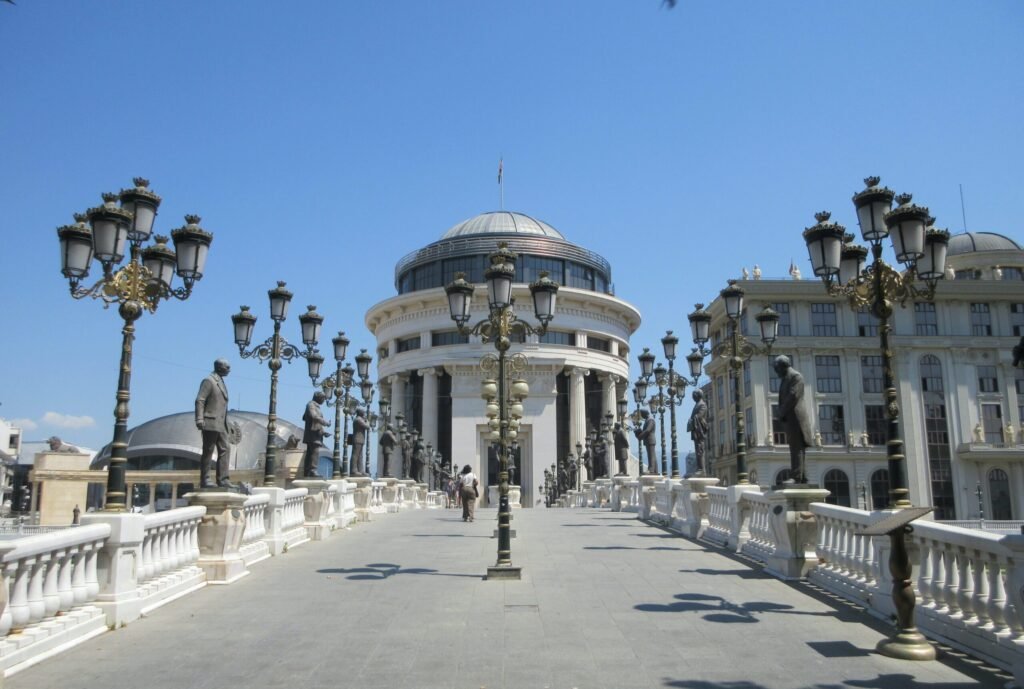One of the most famous residents of Skopje is Mother Teresa, the Nobel Peace Prize laureate and Catholic saint honored by the North Macedonia capital with a Memorial House
I arrived at Ohrid, North Macedonia in the evening. It took a few hours to travel from Tirana, Albania to reach Ohrid. The latter is a lakeside city that has a history that spans centuries.
Lake Ohrid (the location of the city) straddles Albania and North Macedonia. The lake also has the unique distinction as being both a Natural and Cultural UNESCO World Heritage Site. I checked in at my accommodation and walked around the old town. My first impression was that it was a popular local and regional destination. Since its proximity to nature, it felt like a laidback place to visit.
A chill vibe and ancient history
Ohrid’s storied past dates to the time when it was a Greek colony. It used to go by the name “Lykhnidos” during this time. Like the other Balkan cities, Ohrid has a mixed historical and cultural heritage because of its affiliations with various kingdoms other than the Greeks, these include the Romans, Bulgarians, and Byzantines. The city’s old town is one of the earliest inhabited sites on the continent.

Lake Ohrid is the main reason people visit the city. They want to see it and do all sorts of activities from swimming to sunbathing to various water sports during their visit. You can take a leisurely stroll along the boardwalk to soak in the views and get a glimpse of the city’s rich history.
The most photographed view of Ohrid is the Church of Sveti Jovan at Kaneo with the lake as its background. I couldn’t help but take touristy photos when I went. This 13th century church has withstood changes in regimes and the slow march of history. It wouldn’t surprise if the monks of ancient times drew inspiration from and felt solitude whenever they looked at this view.
Ohrid is home to many ancient Christian sites, one of the most important is the Church of Saints Clement of Ohrid and Panteleimon located in Plaosnik. It’s one of the world’s oldest Slav monasteries. The archeological site is the burial ground of St. Clement of Ohrid. The site also showcases the city’s long connection to early Christianity and various civilizations over the centuries.

Perched on a hill, Samuel’s Fort looms over the city with its ancient walls. This grand structure defended the city against invaders and wars.
Fast forward to today, it’s no longer the fortification it once was, but it’s now a popular tourist attraction because of the panoramic views of the city and lake it provides visitors.
Ohrid’s diverse cultural heritage is on display when you visit the Ancient Theatre. It dates to the city’s Hellenistic era (around 200 BC). The Romans later used it for executions and gladiator tournaments. It hasn’t been completely restored but you’ll see vestiges of it. Locals today use it as a venue for various events and festivals throughout the year.
Surrounded by nature and ancient sites, Ohrid’s a lovely and historic city to visit. Its chill vibe is a plus if you just want to take a relaxing stroll around the lake or its winding streets that weave between neighborhoods.
Exploring the capital of North Macedonia
When you think of a list of European capitals, North Macedonia’s Skopje wouldn’t be on it. My curiosity led me to the Balkans and eventually to Skopje.
Like many of the cities in the region, Skopje has an interesting history mixed with warring empires trying to stretch their influence across the continent from the Romans to the Serbs to the Austrians to the Turks to the Soviets.
I saw vestiges of these not only in the capital but also in Ohrid. These influences manifested themselves in the architecture, food, and ancient ruins. I clearly saw the imprint of the Turks when I visited both cities.

Macedonia Square is the beating heart of the city with a few main roads connecting to it. The square is a common meet up point for residents and visitors.
Some of the city’s most beautiful buildings surround the square with the statue of a Warrior on a Horse as its centerpiece. After crossing the ancient Stone Bridge, you’ll find yourself in one of the oldest bazaars in the region.
The Old Bazaar is a winding maze of cafes, restaurants, and stores. I spent a good chunk of my time in the city hanging out here. I bought a few souvenirs and ate local food. This area reminded me the most of Turkiye. The similarities in culture and shared history were difficult to ignore.
Kale or Skopje Fort dominates the city’s skyline with its imposing structure. Early records show that the fort dates to the 6th century. Many emperors and empires have occupied the fort. Its strategic location on the highest point of the city allowed its residents to successfully thwart invasions.
Earthquakes over the centuries have partially damaged the fort, but reconstructions took place soon after. Archaeological excavations that took place over the last few decades led to the discovery of centuries old relics such as coins, ornaments, and church ruins. The fort is also the best spot for overlooking views of Skopje.

One of the most famous residents of Skopje is Mother Teresa. Born and baptized in the city in 1910, she became a Nobel Peace Prize laureate and a Catholic saint for her charity work.
Her Memorial House contains displays and memorabilia of her life. Skopje might not be a top-of-mind destination for trips to Europe, but it’s an interesting addition to your itinerary if you ever decide to explore the Balkans.
It’s convenient to go city hopping in the region because of buses that frequently travel between cities. North Macedonia is also an affordable European country for all types of travelers.
The cities of Ohrid and Skopje have overlapping histories with the countries in the region where the ancient empires from the east and west vied for supremacy. They all left a lasting imprint that has shaped the culture of not only the two North Macedonian cities mentioned, but the other cities in the Balkans as well. – Rappler.com











